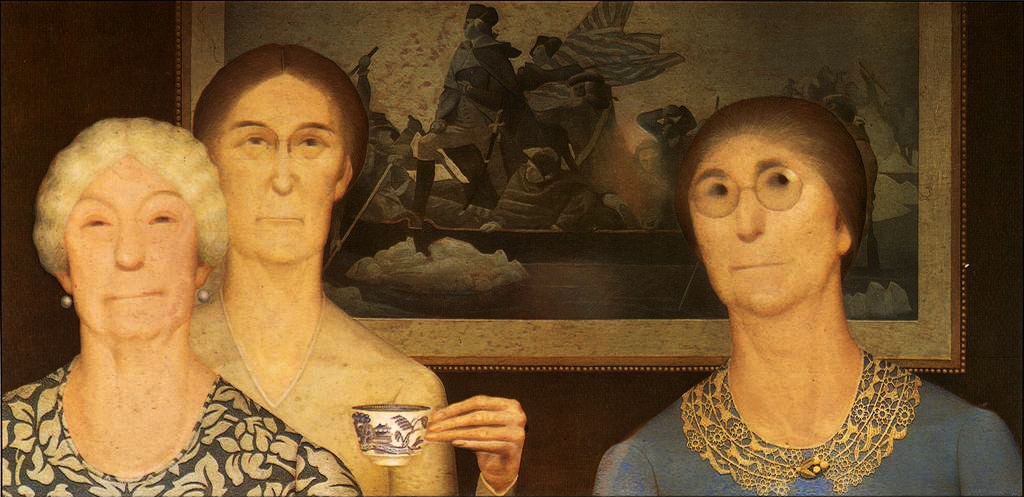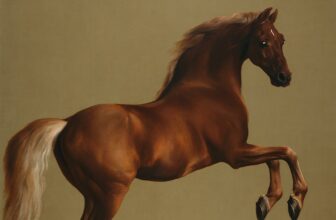
What is The Meaning of Daughters of Revolution Painting by Grant Wood
Grant Wood, one of America’s most iconic Regionalist painters, is widely recognized for his 1930 masterpiece American Gothic. However, another of his compelling and lesser-discussed works, Daughters of Revolution (1932), offers an intricate blend of satire, symbolism, and commentary on American society, tradition, and hypocrisy. In this post, we will delve into the historical context, symbolism, stylistic choices, and enduring meaning of this important painting, exploring what it reveals about the artist, his era, and the subjects he chose to critique.
What is Daughters of Revolution by Grant Wood All About?
At first glance, Daughters of Revolution appears to be a simple, posed portrait of three elderly women dressed in colonial-style attire. However, the painting is a layered satire aimed at a particular segment of American society. The three women stand stoically in front of a backdrop featuring Emanuel Leutze’s famous painting Washington Crossing the Delaware. With tightly pursed lips, pinched expressions, and a self-important air, these women represent the members of the Daughters of the American Revolution (DAR), a lineage-based organization for women who can trace their ancestry to individuals involved in the American Revolution.
Grant Wood’s painting is not a respectful tribute to the organization; rather, it is a biting critique of what he perceived as the group’s self-righteousness, classism, and hypocrisy. In essence, Daughters of Revolution is both a personal and political satire, channeling the artist’s disillusionment with elitist claims to patriotism and cultural superiority.
The Backstory
To fully appreciate the meaning of Daughters of Revolution, it’s important to understand the historical and personal context in which it was painted.
In the 1920s, Grant Wood was commissioned to create a stained-glass window for the Veterans Memorial Coliseum in Cedar Rapids, Iowa. For the production of the window, Wood traveled to Munich, Germany, to consult with experts and source the best materials. At the time, American stained-glass manufacturing was limited, and German craftsmanship was considered superior. Upon learning this, members of the local DAR were outraged that “foreign” (especially German) materials and artisans were being used for a monument meant to honor American war veterans. They protested the use of foreign materials and accused Wood of being unpatriotic.
This incident infuriated Wood. Not only did he view the DAR’s response as narrow-minded and hypocritical, but he also saw it as an affront to the principles of openness, innovation, and global cooperation. The controversy left a deep impression on him, and he carried the grudge for years. Daughters of Revolution was his artistic retaliation, a satirical depiction of the very type of nationalism and faux patriotism that had opposed his work.
Who Painted Daughters of Revolution and How Was It Created?
Grant Wood painted Daughters of Revolution in 1932 while he was firmly established as a key figure in the American Regionalist movement. Known for his sharp detail, precise technique, and distinct style rooted in Northern Renaissance painting, Wood brought a meticulous realism to his satirical subjects. He executed the painting in oil on masonite, a material he often used to achieve a smooth surface conducive to fine detail.
The three figures in the painting are believed to be modeled on actual elderly women from Cedar Rapids, possibly acquaintances or composites, though some historians suggest they might even include Wood’s own mother or acquaintances from his community. Interestingly, it has also been suggested that one of the faces may have been modeled from the artist himself in disguise, hinting at a layer of gender-bending satire and a personal insertion into the critique.
The inclusion of the Washington Crossing the Delaware painting in the background was intentional and ironic. The famous Leutze painting, a romanticized and theatrical rendering of George Washington’s daring Revolutionary War crossing, was itself painted by a German-American artist in Düsseldorf, Germany, in 1851. This irony, DAR members standing in front of a famous “patriotic” painting made in Germany, was not lost on Wood and served to underscore the hypocrisy he saw in their criticism of his own use of German craftsmanship.
What is Happening in the Painting?
In Daughters of Revolution, three elderly women stand in a stiff, formal pose. They are clad in conservative, colonial-era clothing that mimics the fashion of the late 18th century, complete with lace, brooches, and wire-rimmed spectacles. Their expressions are grim and humorless, with a kind of moral superiority radiating from their tightly pursed mouths and direct gazes.
Behind them looms the dramatic image of Washington Crossing the Delaware, a reproduction that dominates the background and reinforces the colonial and Revolutionary War setting. The juxtaposition of these self-serious women with the romanticized patriotism of Leutze’s painting creates a powerful visual irony.
Nothing is happening in terms of action, the women are not engaged in any activity; they are simply posing. But this stillness is part of the point: Wood portrays them as frozen relics of the past, clinging to outdated ideals and asserting their moral and cultural superiority without reflection or context.
Symbolism and Interpretation
1. The Women Themselves
The three women symbolize a conservative, upper-class ideology that equates patriotism with lineage, appearance, and rigid tradition. Their uniformity in dress and expression suggests conformity and self-righteousness. They are not warm or grandmotherly; rather, they are stern and severe, embodying a kind of moral authoritarianism. Their expressions evoke a critique of moral superiority disconnected from real sacrifice or understanding.
2. Colonial Attire
The colonial dress is key to the satire. While the women adopt these clothes to align themselves with the Revolution, their adherence is superficial and performative. They are not Revolutionaries; they are members of a club that venerates the past while often opposing progressive ideas in the present.
3. The Background Painting
The most potent symbol in the piece is Leutze’s Washington Crossing the Delaware, a work already criticized by art historians for its romanticized and historically inaccurate portrayal of the event. Its inclusion in Daughters of Revolution drives home Wood’s satirical message: the DAR’s version of patriotism is as artificial and foreign-influenced as the painting they venerate.
4. German Irony
By referencing a German-made American patriotic painting, Wood highlights the irony of the DAR’s outrage over his use of German materials. The painting thus critiques the selective memory and contradictory standards often employed by those who claim to defend tradition.
What Type of Art is Daughters of Revolution?
Daughters of Revolution is a prime example of American Regionalism, an art movement of the 1930s that focused on rural American themes and values. However, unlike much of Regionalist art, which often idealized American life, Wood’s painting contains strong elements of satire and social commentary.
It also bears the technical influence of Northern Renaissance portraiture, Wood was deeply inspired by the work of artists like Jan van Eyck and Hans Memling, whose detailed, smooth surfaces and precise rendering he emulated. This influence can be seen in the painting’s fine detail, formal composition, and frontal positioning of the figures.
So while it belongs to the Regionalist canon in terms of style and setting, it also crosses into the realms of political satire, portraiture, and symbolic realism.
Where is Daughters of Revolution Painting Located Today?
Today, Daughters of Revolution is housed in the Cincinnati Art Museum in Cincinnati, Ohio. It is part of their permanent collection and is often cited as one of Grant Wood’s most incisive and critical works. The museum provides context for the painting, allowing viewers to appreciate both its historical background and its continued relevance in discussions about nationalism, gender roles, and American identity.
More than 90 years after it was painted, Daughters of Revolution remains sharply relevant. In a world where debates over nationalism, cultural identity, and historical legacy persist, Wood’s painting serves as a reminder of the dangers of sanctifying the past without understanding it. It challenges viewers to consider how patriotism can be co-opted by exclusionary ideologies and how appearances can mask hypocrisy.
Moreover, in an era increasingly conscious of gender dynamics and performative moralism, the painting offers rich ground for feminist and cultural critique. The depiction of elderly women as severe and out-of-touch might seem harsh, but Wood’s target was not their gender, it was the elitist, exclusionary institution they represented.
Grant Wood’s Daughters of Revolution is far more than a simple portrait. It is a complex, biting satire laced with personal grievance, historical irony, and cultural commentary. Through meticulous technique and subtle symbolism, Wood skewers the hypocrisy of performative patriotism and conservative elitism, using humor and irony to make his point.
The painting’s stiff composition, austere characters, and loaded background draw the viewer into a deeper meditation on what it means to honor tradition, and how easily that honor can become a mask for prejudice and closed-mindedness. It stands as one of the most intellectually rich works of American Regionalism, reminding us that art has the power not only to reflect society but to hold it accountable.
As a work of art, Daughters of Revolution is a masterclass in controlled satire. As a historical document, it is a window into the cultural battles of early 20th-century America. And as a statement, it continues to speak to the contradictions and complexities of patriotism, identity, and history.




